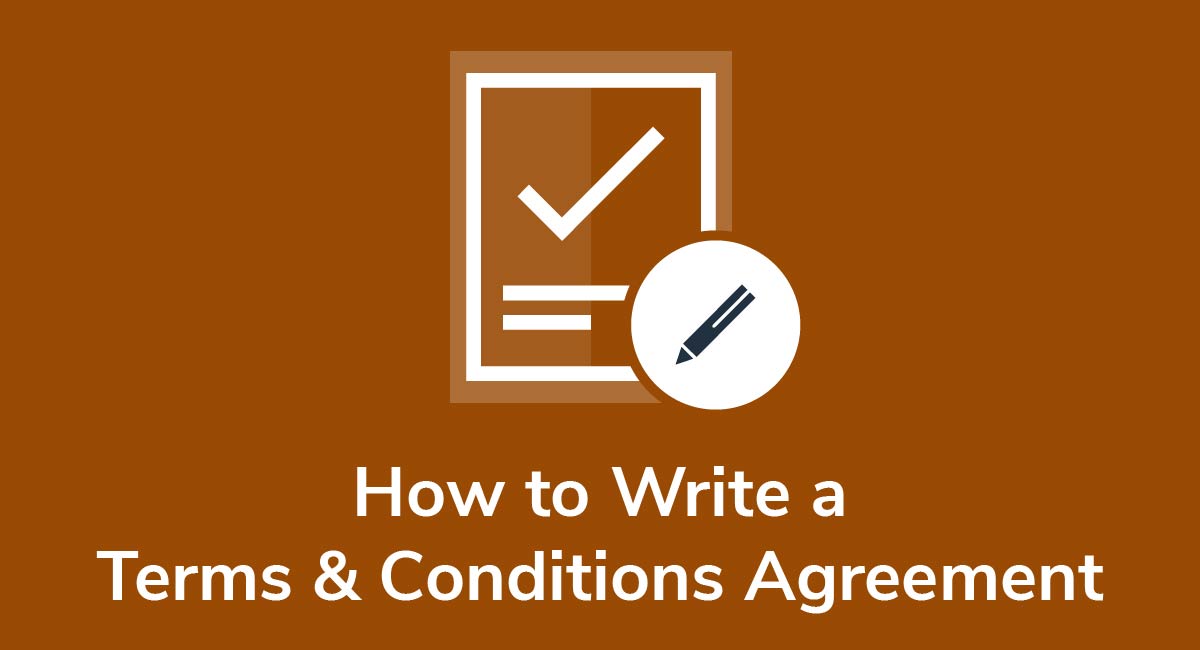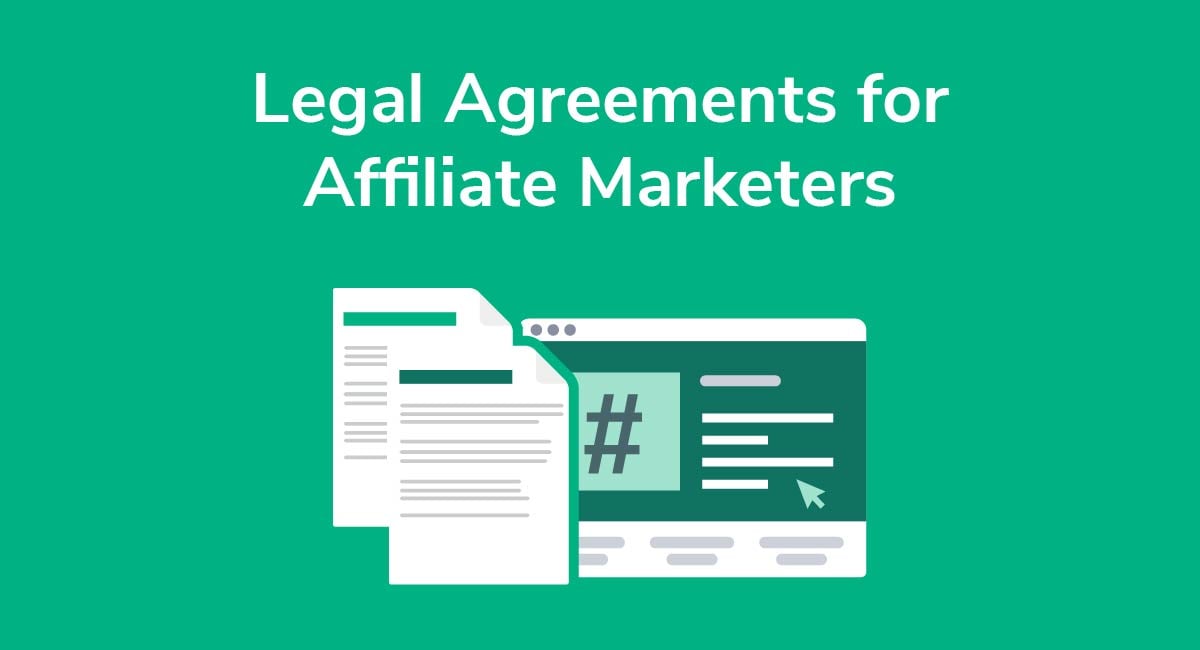Terms and Conditions for Ecommerce Stores
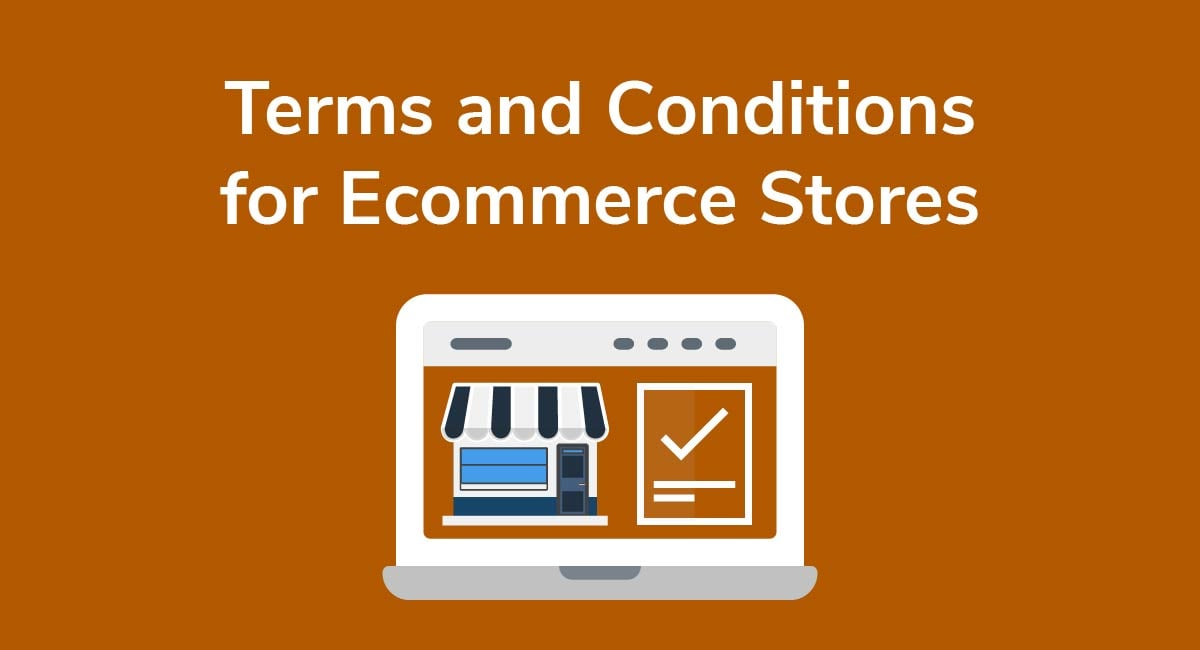
If you sell goods or services online, it's highly recommended that you provide customers with a Terms and Conditions agreement (T&C).
While the law doesn't require any ecommerce store to have Terms and Conditions, we'll show you why having one is so important, and why no ecommerce store should be without this agreement. We'll also help you create your own.
Terms and Conditions agreements are referred to by a few generally interchangeable names, including:
- T&C
- Terms of Use
- User Agreement
- Conditions of Use & Sale
Whatever the exact phrasing, the meaning is the same - it's a legal relationship between parties.
Need Terms and Conditions for your business? We can help you generate a customized Terms and Conditions agreement in around two-three minutes for free. Try our Terms and Conditions Generator and just follow these steps:
- Click on the "Create your Terms and Conditions today" button.
- At Step 1, select the where will you use your Terms & Conditions and click "Next step":
- Add information about your business:
- Select the country and continue to the "Next step":
- Answer the questions about your business practices and click "Next step" when finished:
-
Enter your email address where you'd like your agreement sent and click "Generate."

You're done! Now you'll be able to instantly access and download your new agreement.
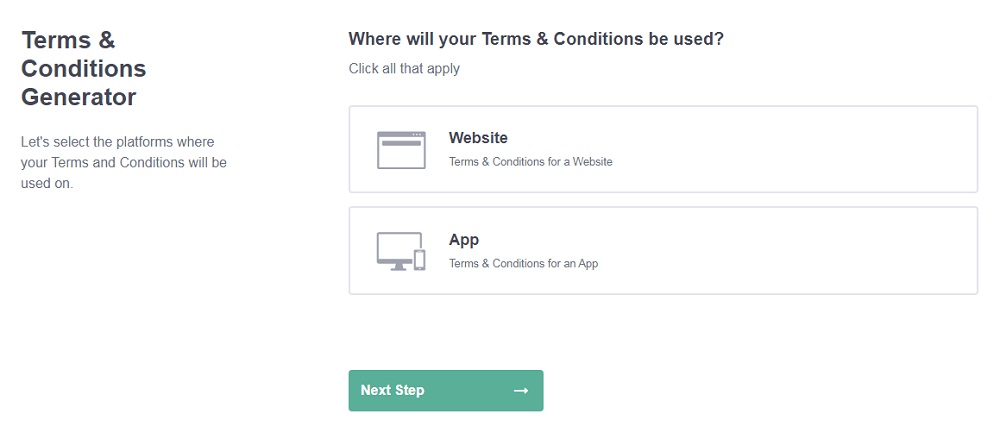
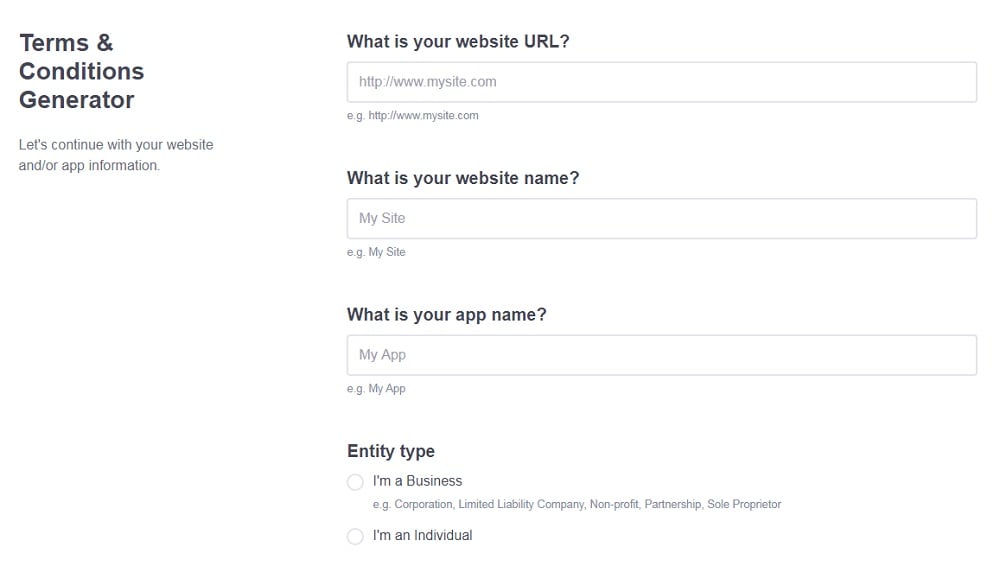
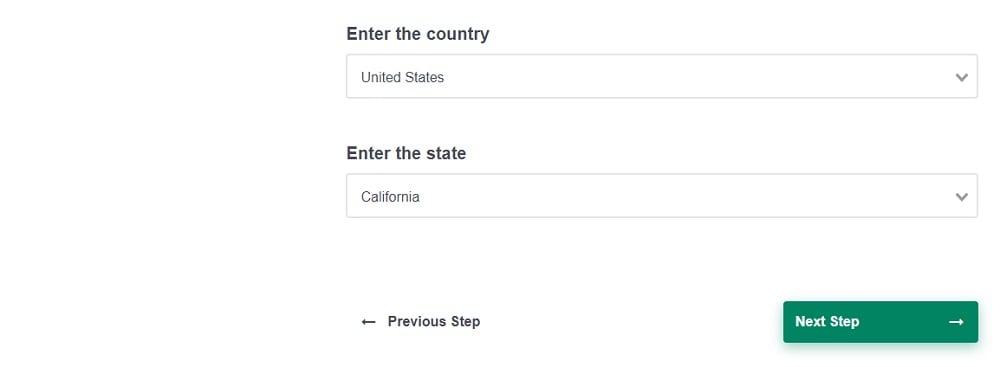
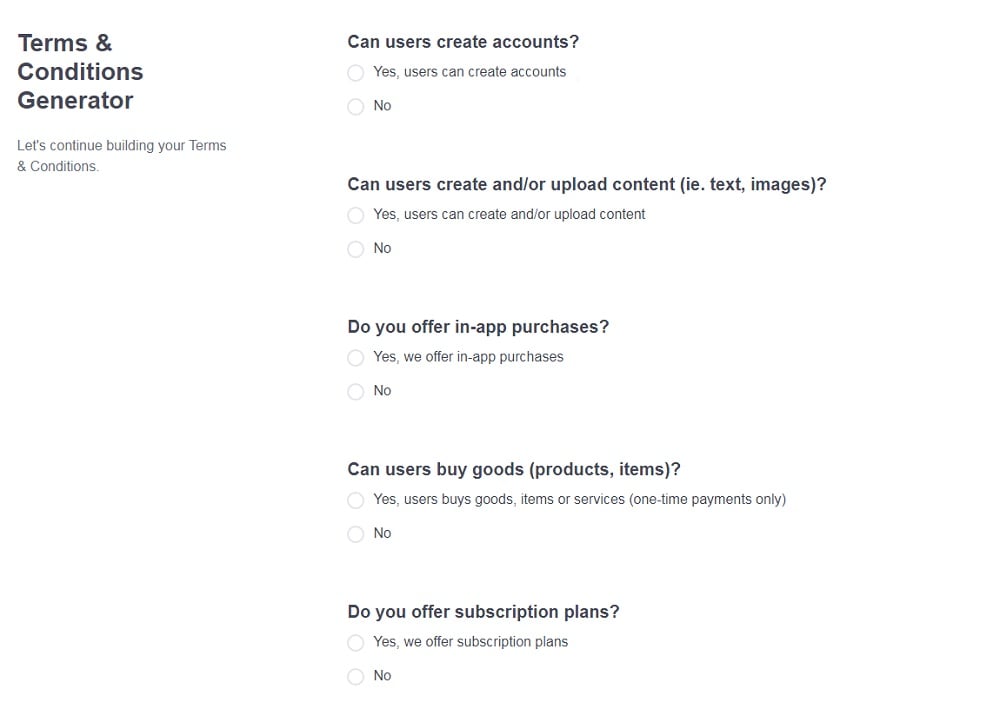
- 1. What is a Terms and Conditions Agreement?
- 2. Why Every Ecommerce Store Needs Terms and Conditions
- 3. Important Clauses for Your Ecommerce Terms and Conditions
- 3.1. The Introductory Clause
- 3.2. The House Rules
- 3.3. Prohibited Uses and Actions
- 3.4. Account Termination and Suspension
- 3.5. Intellectual Property
- 3.6. Payments
- 3.7. Limitation of Liabilities
- 3.8. Promotions and Sales
- 3.9. Refunds and Returns
- 3.10. Amendments to Your Agreement
- 3.11. Jurisdiction & Dispute Resolution
- 3.12. Your Contact Information
- 4. Displaying Your Terms and Conditions Agreement
- 4.1. Website Footer
- 4.2. Payment and Checkout Screen
- 4.3. Account Creation and Login
- 5. Getting Users to Agree to Your Terms and Conditions
- 5.1. Implied Consent/Browsewrap
- 5.2. Checkboxes and Buttons/Clickwrap
- 6. Conclusion
What is a Terms and Conditions Agreement?

A Terms and Conditions agreement explains:
- How consumers may use the website
- Rights and responsibilities of parties
- What you are (and are not) liable for
- Who customers can turn to if there's a problem with the sale
A Terms and Conditions agreement is a contract which spells out exactly what the legal relationship is between the store and the consumer. The agreement should be easy to understand and readily accessible. Most importantly, you shouldn't stuff your Terms and Conditions with complex legal language.
Without Terms and Conditions, it's unclear what the consumer can expect from you, and it's more difficult for you to take action if a user abuses your service.
Why Every Ecommerce Store Needs Terms and Conditions

You might still be wondering why a Terms and Conditions agreement is such a big deal. After all, when we purchase goods from a regular store, we don't sign a contract with the cashier or the manager. Online stores, however, are different beasts.
Although the Terms and Conditions agreement protects consumers, they really protect you, the ecommerce store owner. The Terms and Conditions reaffirms what you cannot be held responsible for, and what actions you're entitled to take.
- You can outline your own return and refund policies. For example, you can decide if the consumer pays for return shipping, and you can decide whether to accept or reject returned items.
- You can clarify that consumers are responsible for any customs or additional VAT fees they might encounter before receiving the goods.
- It's possible to limit your liability so that you aren't liable for inaccuracies such as product misdescriptions or shipping delays.
- You can limit any financial compensation you may pay someone.
- You can protect your intellectual property rights.
- You can reserve the right to delete accounts that violate your conditions, without warning and without explanation.
- You can set out the dispute process if any legal issues do arise.
Essentially, a Terms and Conditions agreement makes it easier to resolve disputes if they arise. Remember, if you're selling services or goods, there's a lot that can go wrong, and it's very often not your fault. The Terms and Conditions are an essential part of any ecommerce store.
Ready to start drafting your own Terms and Conditions agreement? Let's look at what clauses you need, and if there's anything you can't or shouldn't do.
Important Clauses for Your Ecommerce Terms and Conditions

Every Terms and Conditions agreement is unique. The specific terms you include depend on your unique business needs and practices. However, there are some clauses that you can expect to find in every Terms and Conditions agreement if it's going to do its job properly. Let's look at these recommended clauses and see why they're so important for ecommerce store owners to incorporate into their own agreements.
The Introductory Clause
There's no point in having a Terms and Conditions agreement if no one knows who it applies to. Create a short introductory clause to outline who the agreement is between, what the agreement actually is, and when it's triggered.
Ecommerce website Etsy has a great example of an introductory clause. It spells out exactly who the consumer has an agreement with - it varies depending on the consumer's physical location. The agreement is triggered if the consumer uses any Etsy service, even if they're just browsing the site:
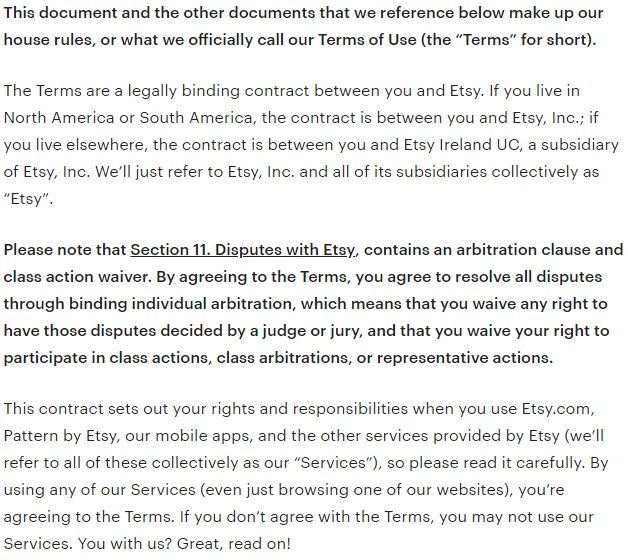
The House Rules
Set out guidelines for creating accounts, making purchases, and communicating with buyers/sellers. The clearer the guidelines, the easier it is for you to suspend or delete an abusive account.
Shopify sets out its 'house rules' under 'Account Terms.' It shows what potential users must do to create a Shopify account, and it puts the onus back on the consumer to protect their own username and password. You don't want consumers coming back and saying someone hacked their account and spent lots of money because they left their password lying around:
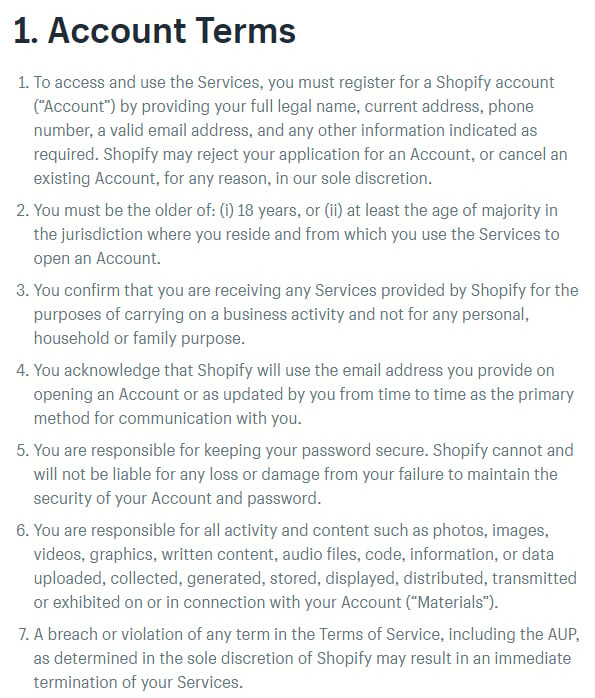
Prohibited Uses and Actions
You should clarify what behavior or content you won't tolerate on your ecommerce platform. Etsy, for example, reminds users never to post obscene, violent, or threatening content. It also prohibits deliberately false and misleading content.
This is crucial to protect the platform's ecommerce reputation - Etsy, as a commercial business, doesn't want associated with fraudulent activity:

You will see that Etsy includes a link to a more detailed 'Prohibited Items Policy' which outlines what content users may not sell through the platform:
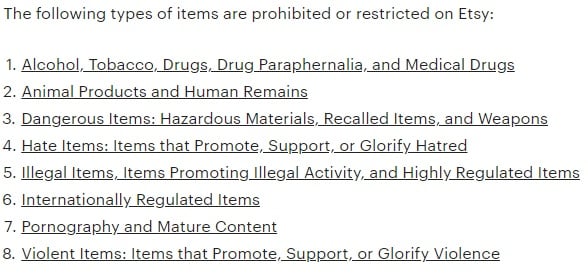
Account Termination and Suspension
Outline what action you can take against ecommerce store users. Keep these clauses as broad as possible, because then you can delete or suspend accounts immediately whenever you deem it necessary.
Society6 includes a very broad termination clause. Thanks to its well-drafted Terms and Conditions, Society6 can remove or suspend any account, at any time, without explanation. Although it's unlikely that Society6 will do this, what matters is that they don't need to explain themselves if an account doesn't align with its T&C:
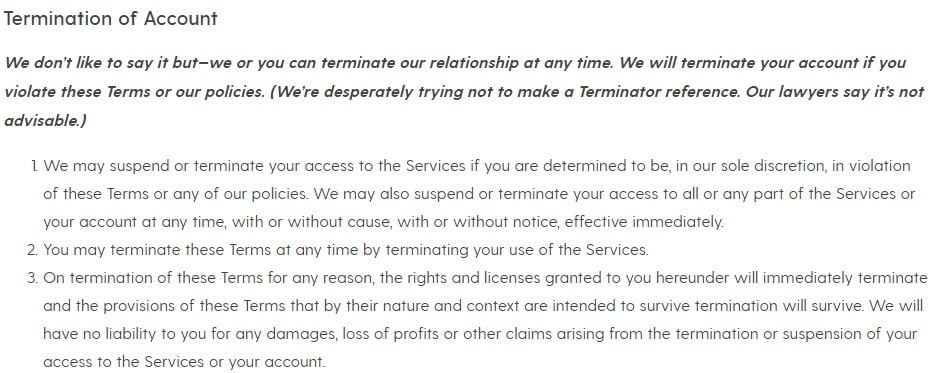
Intellectual Property
Slogans, logos, trademarks, and other commercial branding is your intellectual property. You should protect it and clarify what users may, and may not do with it.
Gymshark retains ownership of its intellectual property. No one else may use its branding on a website. When you run an online store, it's possible that impostors will try to impersonate your site, and so a clause like this is vital:
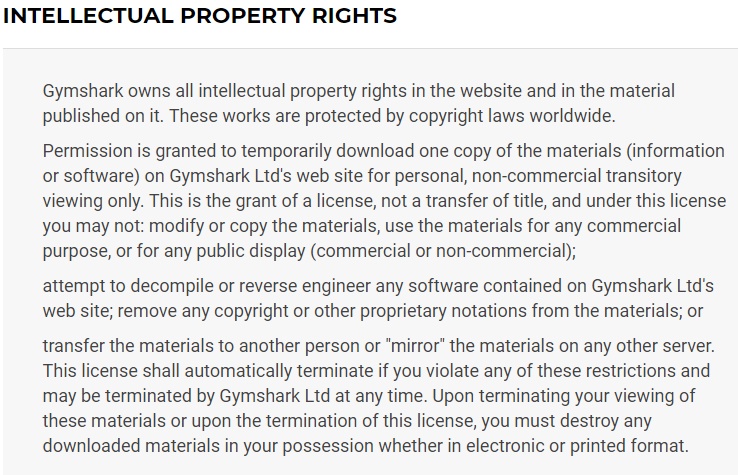
Shopify lets users run ecommerce stores using its platform. Users retain ownership of their own copyright, but other users can view it:
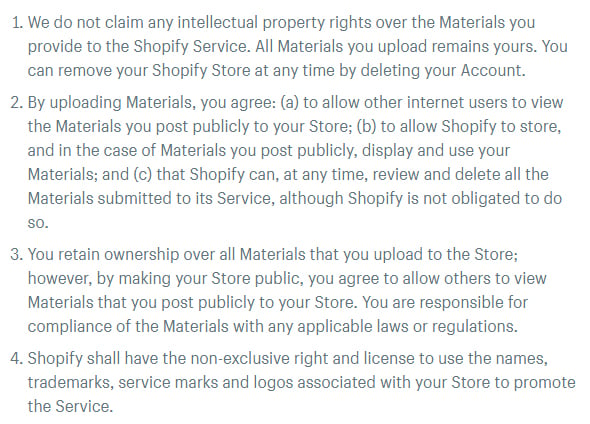
Payments
When it comes to taking payments for items or subscription services, you need to set out what you expect and what actions you can take if payments aren't made or a payment method fails.
Shopify vendors subscribe to run their store from Shopify's platform. The company sets out detailed subscription terms, including the need to provide up-to-date payment information and what the billing intervals are:
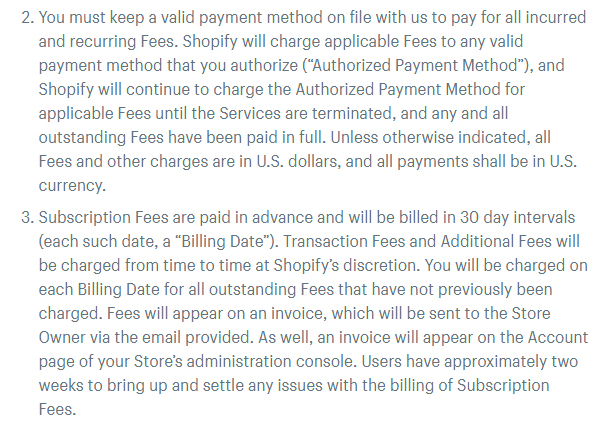
If Shopify can't deduct the subscription fee, it retains the right to suspend the non-paying account:
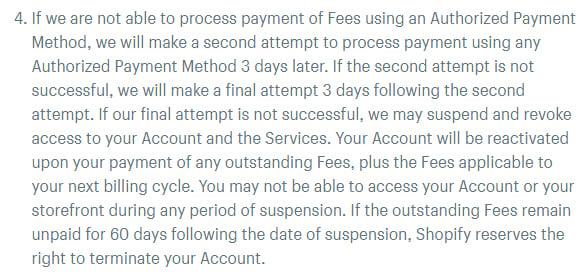
If your customers will be responsible for paying customs or import taxes, make this clear. Gymshark does this well. If the buyer refuses to pay the customs fee, the item is returned and refunded, subject to shipping and handling fees:
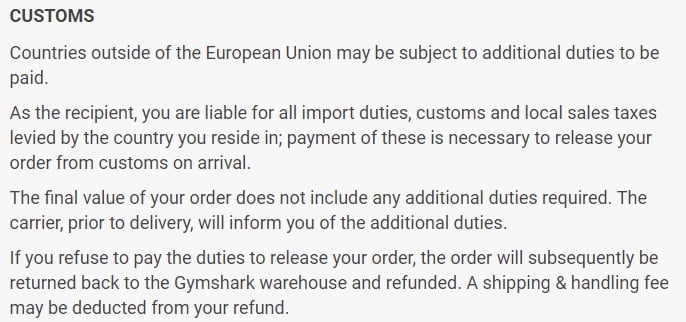
Limitation of Liabilities
Whether it's a misdescribed item or a system error, you don't want to end up liable for every little thing that goes wrong on your platform. You can't guarantee that:
- The system is always error-free
- Users won't be exposed to offensive content uploaded by others
- Third party websites, linked to through advertisements, are secure
- Nothing is ever misdescribed
- Orders will always be fulfilled
Here are some examples of a variety of clauses that will limit your ecommerce store's liability in common scenarios.
When it comes to purchases, you can't always guarantee that every item you sell (or facilitate the sale of) will be flawless. If you sell items from third parties, this is especially important.
Etsy hosts many different vendors, so it includes a clause stating that it isn't responsible for items sold by independent sellers:
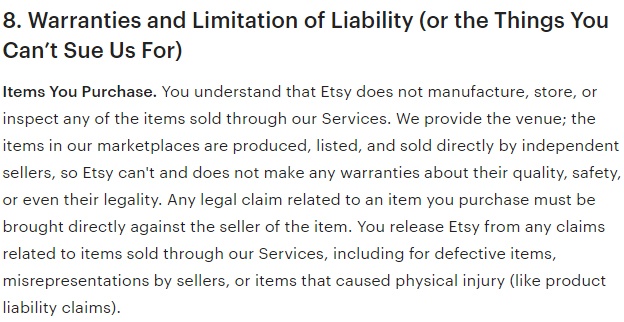
Sometimes content on your site may be inaccurate, be it a third party link that doesn't go where it should, a mistake about sizing of a clothing item or a discrepancy in a price.
Society6 lays out a clear policy concerning misdescriptions. It makes no guarantee that descriptions, pictures, or pricing is error-free. This is a great way to limit liability for site inaccuracies:
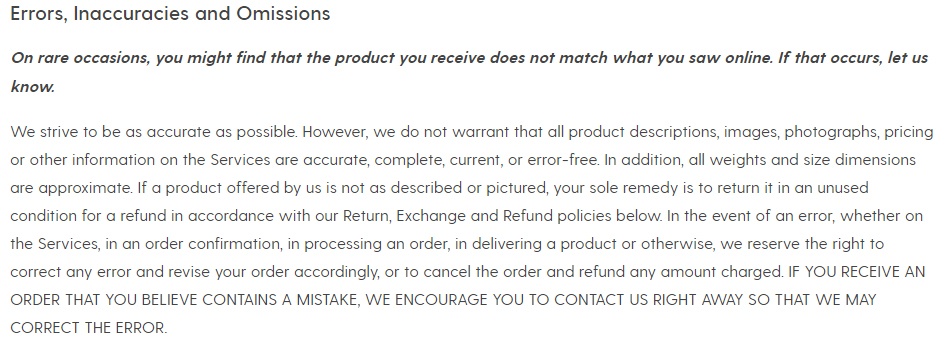
Amazon cleverly reserves the right to charge a higher price if the real price is higher than the price accidentally advertised:

You can't guarantee that every delivery will arrive within a stated time frame or that shipments won't sometimes get delayed. It's wise to limit your liability here.
Gymshark has the right idea by foregoing liability for shipping and delivery delays beyond their reasonable control:

We recommend a clause like this because it's impossible to plan for every eventuality. Amazon also clarifies that delivery times are only estimates, nothing more:
![]()
Society6 reserves the right to refuse to honor an order. This means that if an item unexpectedly goes out of stock after an order is placed or the company decides to stop selling an item, the company has recourse:

Promotions and Sales
You should reserve the right to end sales early and reject promotional codes.
Topshop offers students a small discount on clothing, but it reserves the right to end this offer at any time and refuse someone's student card:

Refunds and Returns
Make sure to lay out when consumers are entitled to a refund, how long they have to return an item, and when you can refuse the refund.
Retailer Tiger Milly sets out a 30-day return policy for unworn goods with the labels still attached. The company sets out very specific guidelines for returning items, stating returns that don't follow these procedures won't be accepted:

Fashion retailer FLEO has a strict no-return policy for sale items, which reduces the likelihood of consumers raising returns issues:

Amendments to Your Agreement
You should update your Terms and Conditions periodically. Etsy, for example, reserves the right to make changes and to only notify users if it believes the changes are material. Otherwise, it's on the user to periodically check the Terms agreement for changes:
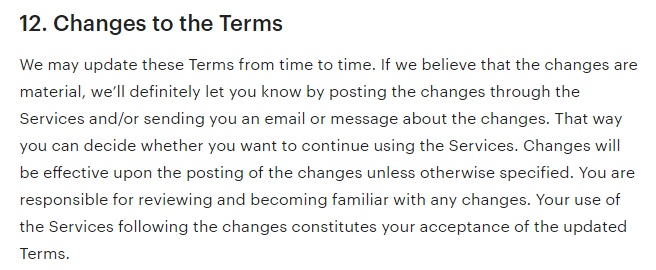
Jurisdiction & Dispute Resolution
You should specify which laws apply in the event of a dispute, and what legal procedures will be used. This is commonly known as a Governing Law clause and is fairly standard. Here's how Etsy does this:

While Etsy respects that other laws may sometimes supercede New York law, New York law is the default. Similarly, arbitration, an informal means of resolving problems, is the chosen dispute resolution:
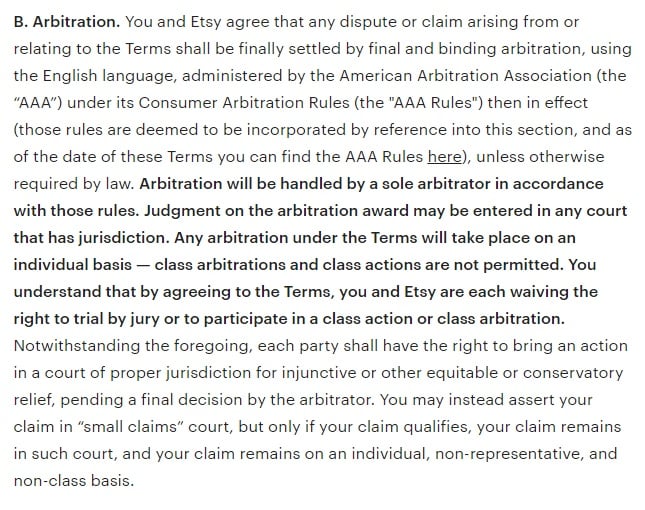
Your Contact Information
Let your users know how to contact you with any questions or concerns they may have. Include as many ways as possible, such as an email address, phone number, mailing address and web form.
Here's how Product Hunt does this:

Now that you know what should go into your Terms and Conditions agreement, let's take a look at some ways to display it to your customers.
Displaying Your Terms and Conditions Agreement

It might sound obvious, but users must be able to easily find your Terms and Conditions agreement. There are a few key places to display them.
Website Footer
This is a great place to display your Terms and Conditions agreement as it's where most stores include a link so shoppers know to look here. It's tidy, subtle, and professional-looking. Here is an example from Etsy showing the Terms of Use along with other legal agreement links:
![]()
Payment and Checkout Screen
Consumers should be able to review your Terms and Conditions before they confirm their order. Make it easy for them to see your Terms by placing a link to it right on your final checkout screen, like Amazon does:

Amazon customers must scroll down past this message to confirm their order, which means they'll definitely have a chance to see the Terms and Conditions before making the order.
You can also add a link and even get consent to your Terms when you request payment information from customers:
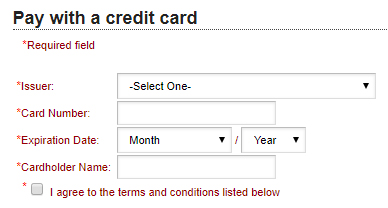
Account Creation and Login
Present your shoppers with a link to your Terms when they sign up for an account with you. It's important for customers to consent to your Terms and Conditions before they create an account on your website.
Ebay, for example, includes links to both the User Agreement and Privacy Notice conveniently below the account creation section, and also states that by creating an account, a user is accepting the Terms:
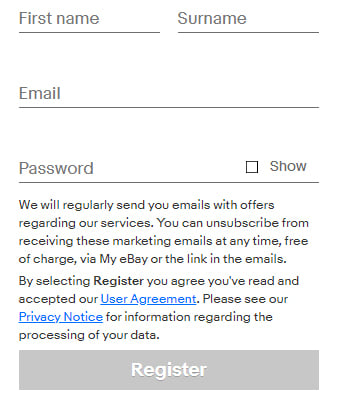
There's also a link to the User Agreement at the footer of the sign-in page, so consumers are free to check the T&C out before they log in again.
Getting Users to Agree to Your Terms and Conditions

The reason it's so important to display links to your Terms and Conditions is because, without reading your terms, users don't know what they're signing up for. And without getting users to agree to your terms, you will have a more difficult time legally enforcing them if you need to.
Here are some common and effective ways to get agreement to your Terms and Conditions.
Implied Consent/Browsewrap
Some ecommerce stores state that by simply signing up for an account, users will be agreeing to the Terms. Shopify takes this approach by placing this as the first sentence in its Terms of Service:

However, it's always best to get express consent. If a user completes some positive step, such as clicking a link or checking a box to say they agree to the Terms and Conditions, the user can't deny the contract.
Checkboxes and Buttons/Clickwrap
Courts generally like to see that both parties expressly agreed to a contract, particularly one that restricts someone's rights in any way, as with a typical ecommerce Terms and Conditions agreement.
Cafepress asks users to tick a box saying they've accepted the Terms before they can create an account:

You can also use a button which says 'I Accept' or something similar, which the user must click to confirm acceptance of the Terms. China Construction Bank takes this approach:
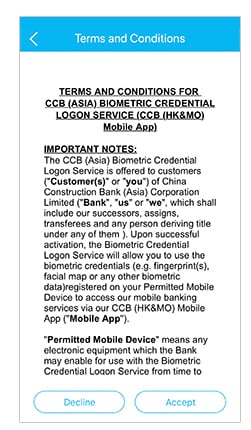
Conclusion
A Terms and Conditions Agreement should be a priority for any ecommerce store. Here are some key takeaways:
- They're not mandatory, but they're vital
- Draft them carefully and include all the important clauses
- Keep them easily digestible but informative
You should draw a user's attention to your Terms and Conditions whenever you think it's important. For example, users should see the Terms agreement before they set up an account, as with MyProtein:

You can include a screen like this at various points, such as before someone makes a purchase. MyProtein does this just before you place an order:
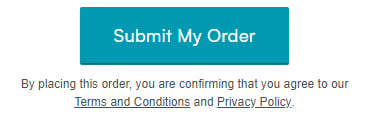
Giving the consumer multiple opportunities to view your Terms and Conditions is the best way to ensure they consent.
Make sure you get clear, unequivocal agreement to your Terms and Conditions from a consumer or user, so they can't say they didn't know the contract existed. Amend your Terms at regular intervals in keeping with general store policies and legal developments.
